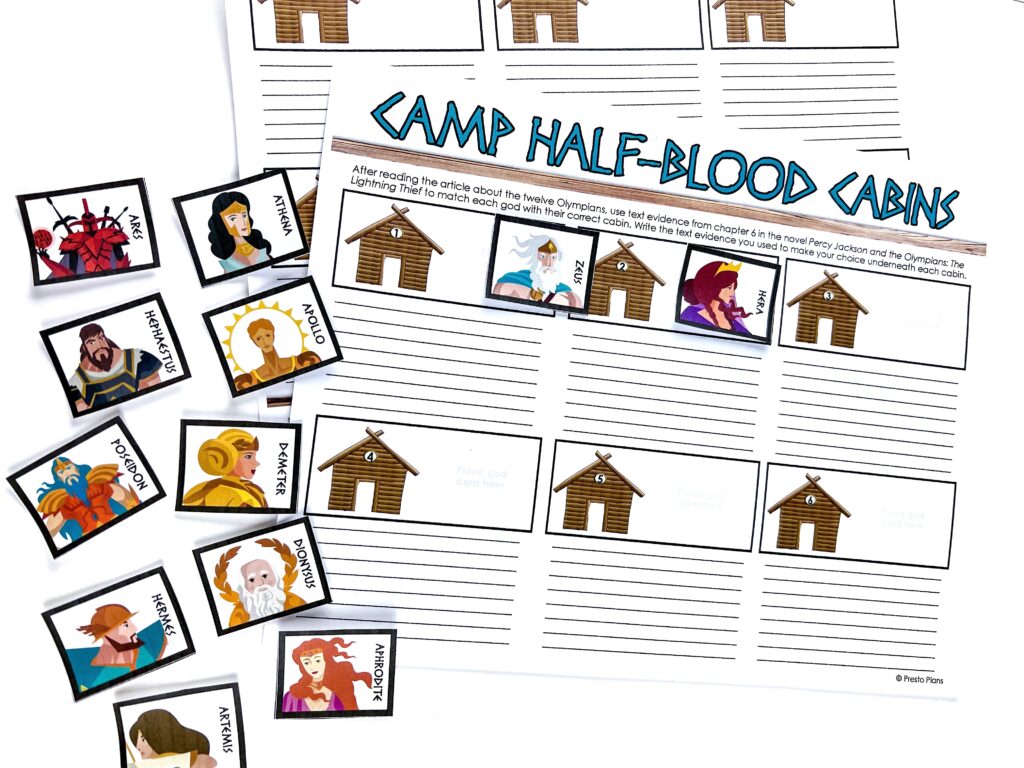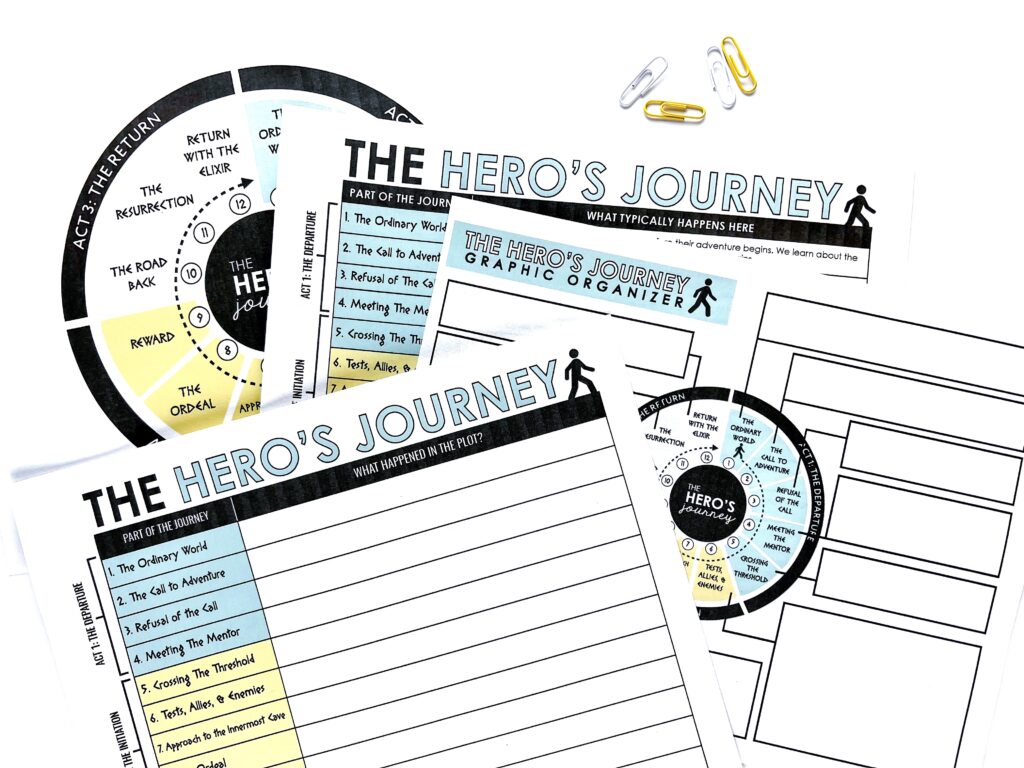PRESTO PLANS
Sent straight to your inbox
CLICK HERE TO ACCESS
Sign up to receive 10 ready-to-use ELA resources your students will love!
10 FREE ELA RESOURCES

10 Creative Activities to Teach Percy Jackson & The Olympians: The Lightning Thief by Rick Riordan
Percy Jackson & The Olympians: The Lightning Thief by Rick Riordan is a masterclass in the mythology of Ancient Greece. I love teaching Percy Jackson for a variety of reasons: the well-rounded and relatable characters, the seamless connections to the complex world of Greek mythology, and the adventure-packed plot!
Immersive activities that allow students to explore the dual worlds of Greek mythology and Percy’s modern-day life offer middle schoolers the opportunity to engage deeply with all aspects of this novel.
Here are 10 of my favorite activities for teaching Percy Jackson & The Olympians: The Lightning Thief.
1. Myth of Kronos
This first activity gets your middle school ELA students up and moving! Early in the novel, Percy re-tells the Myth of Kronos to his classmates during a field trip.
In this myth, Titans Kronos and Rhea had six children: Hestia, Demeter, Hera, Hades, Poseidon, and Zeus. Kronos, fearing that his children would one day overthrow them, ate them all, except for Zeus, who was hidden away by his mother. When he was strong enough to save his siblings, he returned. Kronos threw up all his children – now fully-formed adult gods – and in doing so, provoked a war between him and the other Titans that lasted for ten years!
When teaching Percy Jackson and the Olympians: The Lightning Thief, I like to break students into groups of six or so and provide them with a script for a dramatic interpretation of the Myth of Kronos. The presentation format is up to them (with permission from you, of course). Some creative students prefer to express their scenes on video, while others love the thrill of a live performance.
As they prepare, I might help with a list of supplies or props, but I usually give my students quite a lot of creative freedom with their performances. They have so much fun with their productions that they hardly realize how much they are learning along the way!

2. Track Percy’s journey
In Percy’s journey to locate Zeus’ thunderbolt, he makes his way to many different locations in the United States. I find that maps and trackers help my middle school ELA students get a stronger understanding of the places characters travel to in the book.
At the beginning of the novel, I provide my class with personal maps of the US. As they read Percy Jackson & The Olympians: The Lightning Thief, they can track Percy’s journey across the country, numbering the stops he makes along the way. He visits cities in New York, Missouri, Colorado, Nevada, and California!
Along with the map, I also provide my students with a graphic organizer. Here, they can write about each new location in the book and explain what happened there.

3. Virtual Field Trip
If you can’t get to a real museum to help your students build up background knowledge on Ancient Greek figures, a virtual field trip is the next best thing!
An interactive visit to a virtual museum supports middle school ELA students in understanding more about the myths and characters referenced in the novel, including Medusa, Zeus, and Athena.
When they click on the various art exhibits, they learn more about Greek mythology and various art forms. As they move through the virtual museum, they can jot down their new learning in a graphic organizer for quick and easy reference. Best of all, you don’t even have to leave the comfort of your classroom!

4. Camp Half-Blood Design & Matching Game
When teaching Percy Jackson, I like to encourage my students to focus on Rick Riordan’s descriptive writing. In the novel, Percy receives a tour of Camp Half-Blood, a training facility for Greek demigods located on the north shore of Long Island.
As they read and re-read about the different areas of the camp, students design a 2-D re-creation of the facility based on the quotes that describe each location. Designs can include drawings, images, and color to represent different places at Camp Half-Blood, including the farmhouse, activity centers, cabins, and the woods.

While reading Chapters 5 to 7, students might notice that while there is a description for each of the twelve cabins in the book, the author does not name the god each cabin is connected to. This is a great opportunity to play a matching game!
I like to provide my class with a selection of articles that introduces each of the Olympians. Working alone, in pairs, or in stations, middle schoolers must use text evidence from the article and the novel to match up which god is associated with which cabin!

5. Capture the Flag
There’s nothing students love more than getting up and moving! Imagine surprising your class with a game of Capture the Flag! As you read Chapter 8, ask your class to look for text evidence to explain the rules of the game (as played at Camp Half-Blood).
Next, I like to split my class into an even number of large groups. I find four works well for me, but the most important thing is that you have an even number of groups, as each team will play one opposing group.
Flag Design:
Working collaboratively, your middle school ELA students will develop a team name, a motto, a list of values, and symbols that represent their team. This will guide them as they design a “flag” that can be captured during the gameplay!
Some groups like to choose an image that collectively represents them, and others might prefer to include visuals for each individual group member. Both options are fine!
If you have presentation board, card stock, or another sturdy type of paper, I highly recommend using this. This way, flags are less likely to be damaged during the game.

Playing Capture the Flag:
Now, it’s time to play a game of Capture the Flag! Weather-permitting, this can be a fun game to play outside. Alternatively, I have worked with physical education teachers to play the game in the gym during ELA class time, or as a cross-curricular activity that could be played during a scheduled PE class.
Make sure you have everything you need on hand before you play, including:
- 6 hula hoops
- 3 “flags” (or rags to represent flags)
- The team flags that each group created
I find it really helps to go over the rules as a class before we play the game. This helps each student understand the objectives of the game, as well as how to play safely!
6. Mortals Vs. Gods Newscast Script
Perspective is everything! As students read Chapters 11 to 14, they encounter media from the mortal world that reveal the false perspective that humans have on Percy’s quest. I like to take this opportunity to introduce a collaborative task that invites students to consider multiple perspectives.
Working in pairs, students take on the role of newscaster, preparing two different broadcasts on events from Percy’s quest. The first newscast will be from the mortal world, and the second (on the same topic) is a newscast from the gods!
Newscast topics include:
- The Attack of the Minotaur
- The Attack of Mrs. Dodds and the Women on the Bus
- Attack of Chimera and Echidna
As students plan their work in the provided graphic organizer, invite them to consider how similar events would be viewed differently by humans and the gods or half-bloods. Depending on your resources, students might choose to report their “news” as a live report in front of their classmates or record their broadcasts ahead of time.

7. Design Your Own Camp Half-Blood Necklace
As they read Chapters 15 and 16, students learn that the counselors at Camp Half-Blood choose the most important event of each summer and paint it on a bead. For example, Annabeth’s necklace has beads that feature Thalia’s pine tree, a Greek trireme on fire, and a centaur in a prom dress.
When teaching Percy Jackson, I find this is a great opportunity for my middle school ELA students to pause and make a text-to-self connection. I like to provide time for them to design and create their own Camp Half-Blood necklace, featuring the five most important events of their life.
As they create their necklaces, they choose symbols to represent each bead, and then explain the meaning behind each. Sometimes, I share my own necklace, which has beads that represent my children, places I have traveled, and goals I have accomplished.

8. Similes of the Underworld
I find learning really “sticks” when students can apply their understanding in a game. As you read about Percy’s journey to the Underworld, you might want to take a few minutes to play “Similes of the Underworld!”
In this fun game, I like to divide my class into small groups of four after we have briefly reviewed figurative language terms (especially similes). Once the groups are set up, I let them know that each group needs to appoint one “judge” (you can rotate this position in each round so everyone has a chance to play). Then, I provide printable “fill in the blank” cards to each student (except for the judge).
To begin, give the judge a “simile starter” card related to one of Percy’s experiences in the Underworld (for example, “The weight of my backpack felt like …”). Next, ask each group member to fill in the rest of the sentence. My students can get creative – and sometimes a bit silly – with this. That’s OK!
At the end of the round, the judge awards a point to the person who came up with the best (or funniest, or most creative) simile!

9. The Lotus Hotel and Casino Attractions
When teaching Percy Jackson & The Olympians: The Lightning Thief, I find my students are very interested in The Lotus Hotel and Casino, where Percy and his friends become trapped. During this section, my students love brainstorming ideas for new attractions that they think would entrap children or teenagers for the longest periods of time!
Once they discuss their ideas, each student selects five of their favorite new attractions to include in their “redesigned” version of The Lotus Hotel and Casino. Each attraction (along with a symbol to represent it and a description of why they chose it) can be described on a graphic organizer.

10. Hero’s Journey
The Hero’s Journey is a common plot pattern in fiction. It involves a hero who goes on an adventure (often reluctantly), faces a series of challenges in a new or unknown world, achieves victory, and returns home changed in some way.

As I wrap up my novel study, I like to teach my students about all the parts of the Hero’s Journey with a presentation, handout, and circular graphic. After that, I have them work alone or in groups to apply what they learned to The Lightning Thief to determine if it follows this pattern.
There you have it! I hope you have as much fun teaching Percy Jackson & The Olympians: The Lightning Thief as I do!
Do you have reluctant readers in your classroom? Check out my 10 Tips to Engage Reluctant Readers in Middle School.
Looking to empower and engage your student readers? Have a look at the Empowered Readers course!
Search the blog for what you are teaching
GIVEAWAYS
sent straight to your inbox!


share this post